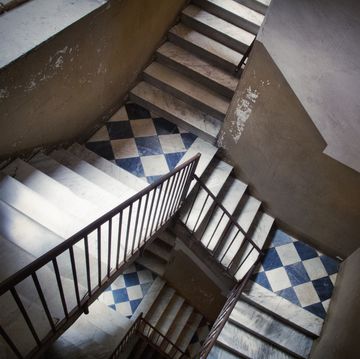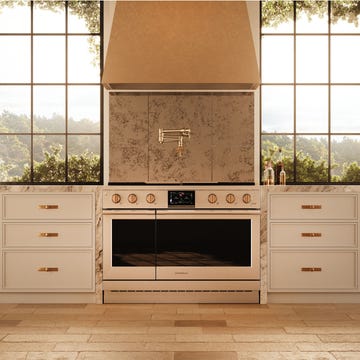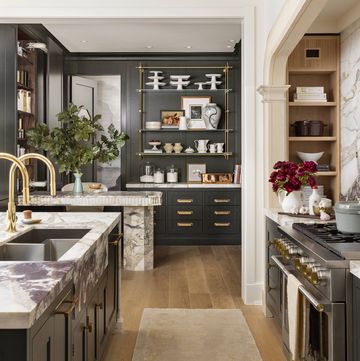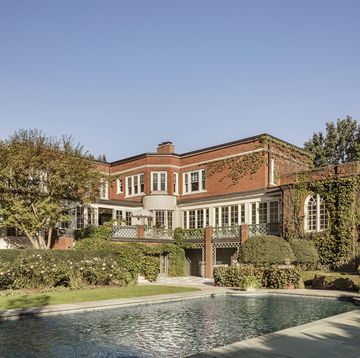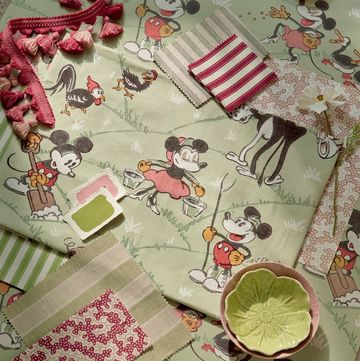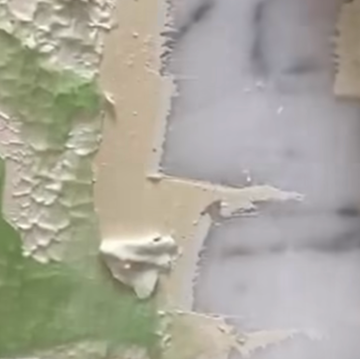Lately, the internet has brought us a nonstop series of shocking underground discoveries: a hidden indoor pool, an adorable dog, and even an entire city to name a few. So at this point, we should expect the unexpected when it comes to home renovations on TikTok. However, the latest viral unveiling still managed to leave us dumbfounded. People are finding hidden indoor wells within their old homes.
TikTok's @mortylad, a.k.a. The Well Guy, stumbled upon such a discovery during a kitchen renovation when he was putting in heated floors. Upon demolishing the original foundation, the UK-based TikToker came across some gravel and wet earth—a panic moment which was resolved when it was determined that the mud pit was actually a 300-year-old well that may have been part of a carriage house. That's when he decided to celebrate the old well, instead of filling it in, and to make it a design feature in his renovated kitchen.
To restore the structure, the Well Guy excavated and removed the mud, discovering that the well is 17-feet deep. He then noticed that there were some bubbles coming up, which he promptly tested for hazardous gas. Luckily, it was nothing toxic and likely just air. That settled, he used reclaimed brick to build up the rest of the well to the level of the new ground floor, installed lights, and worked with a metal and glass fabricator to create a custom-fit extra-thick glass top. "The well is part of our home’s history, and we want to preserve that," narrates the Well Guy's Wife in one of the videos.
Apparently, England is full of old houses with hidden wells. Emma Harrison, of Malvern Hills, Herefordshire, England, is also documenting the process of restoring a boarded up well via TikTok @victoriahouseinthehills. She knew about the well when she and her husband bought the house, and explains, "The well is in the current kitchen, which is an extension," Harrison says. "It would have originally been the garden and the well would have been the main source of water to the house back when it was built in 1897."
For Harrison and her partner, the well wasn't a drawback but a source of entertainment. As soon as the couple got the keys, they tied a string to a mug to find out how far it went down, and learned it goes as deep as 20 feet! "The water is really clear and clean, we have bought a water testing kit which we need to try to see if it's drinkable," Harrison says. Later on, they went fishing for treasure and pulled up some rusty nails, a coin, and even a horse shoe, which Harrison plans to hang up in the kitchen once the renovation is done, at the start of next year. "We're hoping to run lights down to the bottom of the well and put a glass top on it, making it a feature in the kitchen," she adds. "We love period features, especially quirky ones, so it will be amazing to see this everyday."
Even if you live stateside, and your home is not from Victorian, Edwardian, or Georgian eras, it may still harbor a secret well. According to WellOwner.org, people added wells to basements and under porches as a way to keep the water pumps from freezing or having to go outside in cold weather. If you do find one, call a professional contractor before you start a TikTok channel.
You can find a water well contractor in your area via the WellOwner.org directory. The reason you'll want one is so that they can check and "be sure the well isn't leaking hazardous gasses, such as methane," says Jay Sanders, owner of Castle Dream Construction, basement waterproofing and foundation repair company in the Baltimore area. "Methane can enter a well from nearby sources such as cracked pipelines, sewers, and even naturally if the well was drilled into sediment."
You'll also want to check that water isn't seeping into your basement [or any other space], as that can lead to mold and mildew growth. If you do decide to keep the well, adding a sump pump can be an efficient way to transfer the extra well water away from the basement to help reduce moisture, Sanders says. And it's definitely a good idea to test the water. Wells can harbor "iron bacteria," which is a mix of living and dead bacteria, their secretions and metal hydroxide particles that can all give off a sulfide odor and can tinge the water red. Then there is the soil and vegetation-based coliform bacteria, which is generally harmless, but you would then want to do an E. coli follow up testing. Even if the water testing is A-ok, you probably don’t want to drink it anyway. Just use it to water plants or for other household needs, Sanders suggests.
If you do decide to keep the well, in addition to the preliminary inspection as well as potential reinforcements to bring a well into this century, plan to have an annual inspection. This includes flow and water quality tests, as well as valve and electrical check, if you have a pump.
In the past, an indoor well was a status symbol of convenience and luxury that kept one from trending outside for a cup of water. According to Sanders, most people opt to fill in the well once it is discovered and examined as there is no real need for it in this age of running tap water. Once you decide to seal it, don't just dump a bunch of soil or concrete down the hatch. You'll need a well contractor, and their equipment, to do the job properly. Note that sealing procedures can vary state to state and homeowners are required to reach out to their local department of environmental protection or water quality division to document the discovery or if you want to seal it back up.
No matter what you decide to do with your well, let it be a statement of character in your home. "People have commented that it is a bit scary to have a huge hole in your kitchen," Harrison says. "But the fact that architecture from hundreds and hundreds of years ago still stands strong today is a testament to the time and effort that was put into building them." Plus, you can always fish for treasure.


